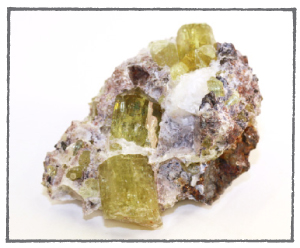APATITE

PART OF A SERIES OF PHOSPHATE MINERALS, apatite is a group of minerals that includes chlorapatite (which contains chlorine), fluorapatite (named for the presence of fluorine), and hydroxylapatite (which contains hydroxl). Its forms can be complex, and its colors are intense and vary widely, leading to the etymology of the mineral’s name from the Greek word apate, meaning “to deceive.” In its early mining history, apatite was often mistaken for aquamarine and amethyst. The most significant deposits of apatite are found in North America and Russia.
The nature of gem therapy is somewhat color based, and as a result, there are varying thoughts on the healing properties of apatite. The most notable and most often used types are blue apatite, green apatite, and golden apatite. Blue stones are considered a wind element and are believed to clear cluttered minds and connect one with past or altered life visions. Green apatite (pictured) is a water element and is believed to grant one a vision of one’s ultimate purpose, while golden apatite is said to give its bearer reassurance in social situations and to grant courage.